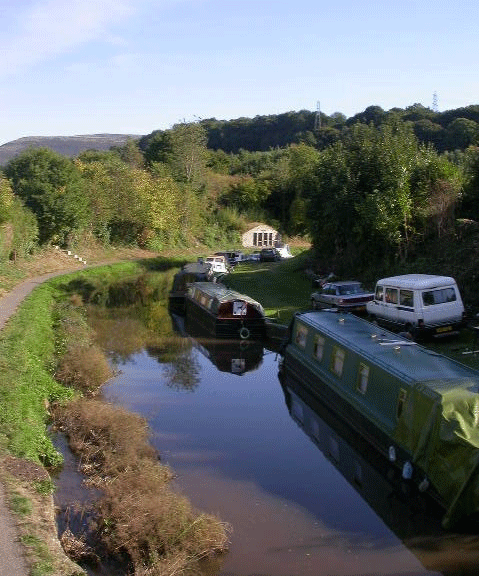Clydach Gorge
008 Gilwern

HLCA 008 Gilwern
Industrial railroad/tramroad and canal corridor and junction; canal wharfs; industrial rail/tramroad and canal settlement; commercial centre; ribbon development augmented by later 20th century infilling; industrial manufacture and milling; water supply.Back to Map
Historic Background
The historic landscape area of Gilwern originated from the development of the Brecknock and Abergavenny Canal, its location at the junction of the steep Clydach Gorge and the Usk valley became the junction of the Clydach Railroad and the canal, prior to this the area had been farmland. Construction began on the Clydach Railroad in 1793 by the Brecknock & Abergavenny Canal Co. in an attempt to provide early revenue; the line linked the Gellifelen collieries and ironworks at Beaufort to Glangrwyney Forge in the Usk Valley. In 1796 work started on the canal, and in 1797 a tunnel was built to accommodate the railroad. The first arch of the tunnel was added in 1809 to carry the Llam-march Tramroad to the Clydach Iron Co.'s wharf.
The wharfs at Gilwern formed the strategic core of the Canal Company's early plans. Gilwern was the location of the canal administration and Agent's residence. The area was also the location of the Clydach Iron Company's Wharf at the head of the Llam-march Tramroad and served by the Clydach Railroad, the Llanelly Wharf and Public Wharf (Clydach Wharf), both served by branches of the Clydach Railroad authorised in 1797. From here it was intended that all iron, coal and lime would be loaded and dispatched north to the agricultural areas of Breconshire, Radnor and Herefordshire; or south to industrial centres and the docks at Newport. Many other wharves were later established, but Gilwern remained one of the busiest until canal trade declined with the coming of railways during the 1860s. The Brecknock Boat Co. (1797-1866) was the principal carrier over the canal, trading in coal and limestone, and owner of several mines; when it started trading in 1798 it operated from the Public Wharf. Llanelly Wharf below Auckland House was the main wharf for Joseph and Crawshay Bailey's Nantyglo Ironworks, and Kendall and Bevan's Beaufort Ironworks from 1817 to 1821. Auckland House (Grade II Listed) and the adjacent Auckland Cottages were built as warehouses for the wharf.
The area retains many features associated with the business generated by the canal. Aqueduct Cottage, built to house wharf workers, is an important example of industrial worker's housing.
Historic Landscape Characteristics
Gilwern is characterised as a nationally important canal/railhead settlement based around the junction of the 18th century Clydach Railroad and Llam-march Tramroad. The main characteristics come from the canal and associated features such as the wharfs, and Machine House (Grade II Listed), built in 1810 to control the operation of the adjacent weighing machine.
An impressive and characteristic feature of the area is the Gilwern embankment (SAM: MM251(MON); Grade II* Listed) built in 1797, during an early phase of construction to carry both the canal and aqueduct of the Brecknock and Abergavenny Canal, including revetment walls and overflow bridge. The feature, now disguised by mature trees comprises a massive earth bank over a large culvert carrying the River Clydach. Other canal-related structures include bridges and water supply features, such as culverts and leats.
The area also contains other industrial features such as the Limekilns at Auckland House (Grade II Listed), and the now converted Dan-y-Bont Woollen Mill, with its adjacent bridge over the Clydach River (Grade II Listed).
The early industrial settlement, comprising a core of ribbon development, existed along the main Abergavenny Road; the short row, with rectilinear yards to the rear, predominating. A scatter of industrial (warehouses etc) buildings around the canal and east of the Mill at Dan-y-Bont, including the Listed Rock Cottage (Grade II) is also shown on the Tithe of 1840. The area today boasts Public Houses and Inns close to the Canal, a Post Office, a post-medieval church and three non-conformist chapels. The latter are Hope Baptist, dated 1876, gable-entry type in Old Red Sandstone with long, round-headed windows; the United Reformed Church (Congregationalist) dated 1886 in the Gothic Style of Pennant sandstone with yellow brick dressings, and a Wesleyan Methodist Chapel of 1848.